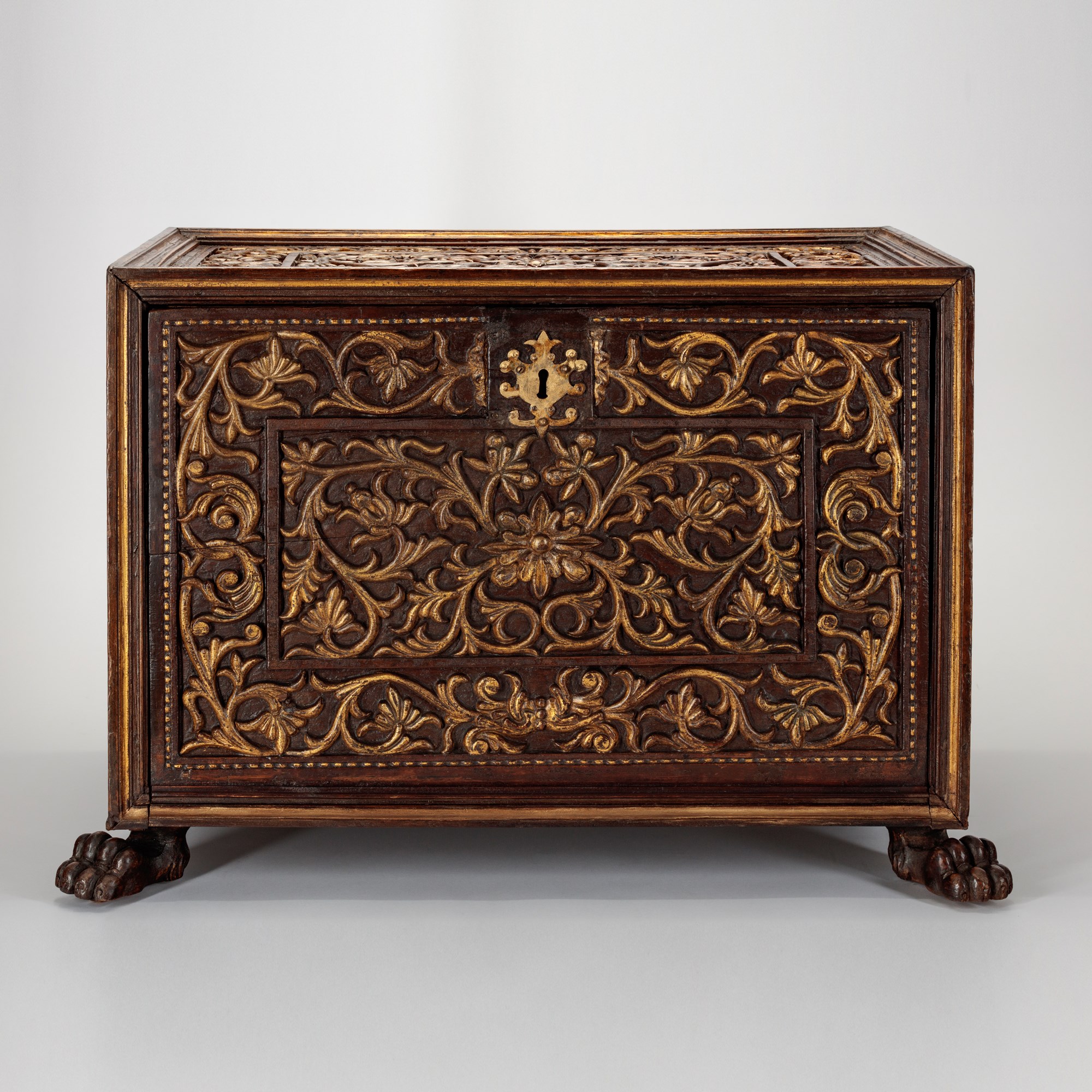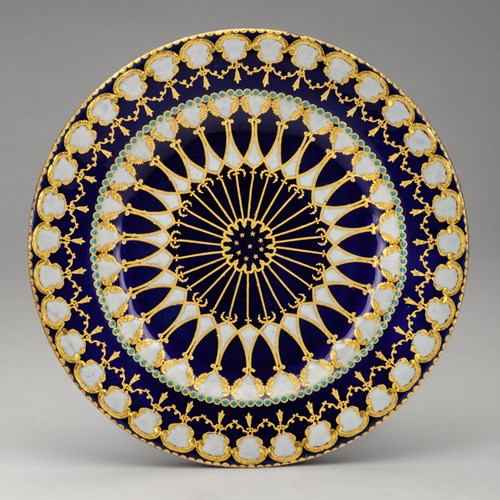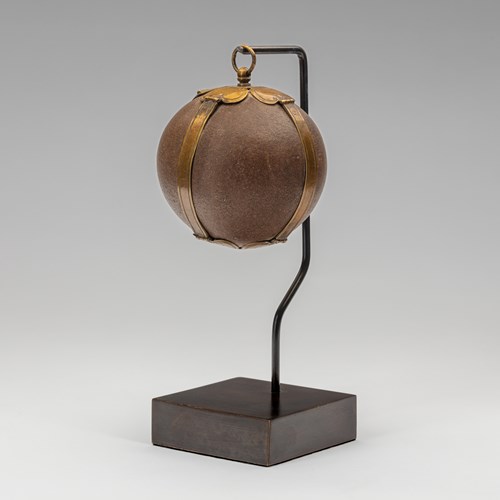Marketplace
Drop-Front Writing Cabinet
Drop-Front Writing Cabinet
Period Early 17th century
Origin South China
Medium Camphor wood (Cinnamomum camphora)
Dimension 52 x 70 x 46 cm (20¹/₂ x 27¹/₂ x 18¹/₈ inches)
Made for the European market
Stock No.: A5277
A drop-front writing cabinet probably made from camphor wood (Cinnamomum camphora), rectangular in shape and set with protruding stepped mouldings covering the edges. It rises from carved lion feet on the front and bracket feet on the back. The gilt iron fittings consist of the lock plate on the exterior surface of the drop-front and on the central interior drawer, the side handles, the hinges set on the inside and the pullers of the interior drawers, which are all fire gilded. The decorative arrangement of the exterior surfaces consists of a large central field – rectangular on the front, top and back, and almost square on the sides – with a narrow, beaded border. Each exterior panel, except for the underside and back, is deeply carved, lacquered and gilded, with a similar design of vegetal and flowering scrolls typical of this southern Chinese production made for export to Europe. On the exterior, the gilded vegetal decoration in high relief contrasts with a rich, dark brown lacquered ground. When opened, the present writing cabinet reveals a similarly exuberant floral decoration carved in relief and covered in gold leaf. It is fitted with four tiers of drawers, with a large central drawer occupying the height of two tiers. The upper and bottom tiers each have two drawers; while the two central tiers have shorter drawers which are placed on either side of the vertical central drawer. The high-relief carved decoration on the drawer fronts consists of highly stylised plants set in symmetry with two main branches within curling leaves. The carved decoration is similar in design to decoration found in other media such as the moulded ceramics of the Ming dynasty (1368–1644), namely glazed earthenware tiles which were used to decorate temples and palaces. On the underside of the drawers and on the corresponding wooden structure there are Chinese characters (each set of two characters comprising the same character plus a different numeral). This system of assigning matching characters to each drawer and compartment would ensure that the drawers fitted into their intended positions; a sign of thorough planning which may be seen in other examples of contemporary Chinese furniture.1
Like other small pieces of furniture of the same origin, which were probably used as jewel cabinets, the present drop-front writing cabinet belongs to a rare group of objects, of which some examples have recently been identified and published.2 Some feature the same protruding stepped mouldings running along the edges, and others the same type of comb joint. The production of these pieces of furniture, modelled after contemporary European prototypes, is almost certainly linked to commissions from Portuguese noblemen and rich merchants living in Asia, namely in the south coastal regions of the Guangdong, Fujian and Zhejiang provinces.3 Although the design and sumptuous decoration of these pieces is unlike the more sober style of the best-known Ming furniture, they correspond perfectly to how the first pieces of Chinese furniture for export to the European market are recorded in contemporary Portuguese documents.4 Some documented examples may be found in the inventory drawn up in 1570, of the estate of Simão de Melo Magalhães, Captain of Malacca from 1545 to 1548, divided between his widow and children: “one writing cabinet with silver mountings and also its lock with gilded drawers and silver pullers; one gilded writing cabinet from China; two round boxes from China each with two compartments, one gilded and the other worked in black damascened; and one old casket from China painted in red and gold.”5 These were certainly embellished with either Chinese decorative schemes and repertoire like the present example, or Renaissance motifs and compositions copied from European prints all in gold leaf set on a black or red lacquered ground.
Footnotes:
1. Berliner 1996, pp. 12–15.
2. Crespo 2016, pp. 288–339, cats. 25–27.
3. Krahl 2007; Crespo 2015.
4. Bastos 2013; Crespo 2015.
5. Crespo 2014, pp. 44 and 105.
Bibliography:
Bastos C. ‘Things from China: trading, disclosure and ownership of Chinese Furniture in Portugal 16th to 18th century’, in Curvelo, A. (ed.). The Exotic is never at home? The presence of China in the Portuguese faience and azulejo (17th–18th centuries), Lisboa, Museu Nacional do Azulejo, 2013,
pp. 145–61.
Berliner, N. et al. Beyond the Screen. Chinese Furniture of the 16th and 17th Centuries, Boston, Museum of Fine Arts, 1996.
Crespo, H. M. Jóias da Carreira da Índia, Lisboa, Fundação Oriente, 2014.
Crespo, H. M. ‘Global Interiors on the Rua Nova in Renaissance Lisbon’, in Gschwend, A. J., and Lowe, K. J. P. (eds.). The Global City. On the Streets of Renaissance Lisbon, London, Paul Holberton publishing, 2015, pp. 121–139.
Crespo, H. M. Choices, Lisboa, AR-PAB, 2016.
Krahl, R. ‘The Portuguese Presence in the Arts and Crafts of China’, in Levenson, J. A. (ed.). Encompassing the Globe. Portugal and the World in the 16th and 17th Centuries, Vol. 3, Washington, Smithsonian Institution, 2007, pp. 235–241.
Stock No.: A5277
A drop-front writing cabinet probably made from camphor wood (Cinnamomum camphora), rectangular in shape and set with protruding stepped mouldings covering the edges. It rises from carved lion feet on the front and bracket feet on the back. The gilt iron fittings consist of the lock plate on the exterior surface of the drop-front and on the central interior drawer, the side handles, the hinges set on the inside and the pullers of the interior drawers, which are all fire gilded. The decorative arrangement of the exterior surfaces consists of a large central field – rectangular on the front, top and back, and almost square on the sides – with a narrow, beaded border. Each exterior panel, except for the underside and back, is deeply carved, lacquered and gilded, with a similar design of vegetal and flowering scrolls typical of this southern Chinese production made for export to Europe. On the exterior, the gilded vegetal decoration in high relief contrasts with a rich, dark brown lacquered ground. When opened, the present writing cabinet reveals a similarly exuberant floral decoration carved in relief and covered in gold leaf. It is fitted with four tiers of drawers, with a large central drawer occupying the height of two tiers. The upper and bottom tiers each have two drawers; while the two central tiers have shorter drawers which are placed on either side of the vertical central drawer. The high-relief carved decoration on the drawer fronts consists of highly stylised plants set in symmetry with two main branches within curling leaves. The carved decoration is similar in design to decoration found in other media such as the moulded ceramics of the Ming dynasty (1368–1644), namely glazed earthenware tiles which were used to decorate temples and palaces. On the underside of the drawers and on the corresponding wooden structure there are Chinese characters (each set of two characters comprising the same character plus a different numeral). This system of assigning matching characters to each drawer and compartment would ensure that the drawers fitted into their intended positions; a sign of thorough planning which may be seen in other examples of contemporary Chinese furniture.1
Like other small pieces of furniture of the same origin, which were probably used as jewel cabinets, the present drop-front writing cabinet belongs to a rare group of objects, of which some examples have recently been identified and published.2 Some feature the same protruding stepped mouldings running along the edges, and others the same type of comb joint. The production of these pieces of furniture, modelled after contemporary European prototypes, is almost certainly linked to commissions from Portuguese noblemen and rich merchants living in Asia, namely in the south coastal regions of the Guangdong, Fujian and Zhejiang provinces.3 Although the design and sumptuous decoration of these pieces is unlike the more sober style of the best-known Ming furniture, they correspond perfectly to how the first pieces of Chinese furniture for export to the European market are recorded in contemporary Portuguese documents.4 Some documented examples may be found in the inventory drawn up in 1570, of the estate of Simão de Melo Magalhães, Captain of Malacca from 1545 to 1548, divided between his widow and children: “one writing cabinet with silver mountings and also its lock with gilded drawers and silver pullers; one gilded writing cabinet from China; two round boxes from China each with two compartments, one gilded and the other worked in black damascened; and one old casket from China painted in red and gold.”5 These were certainly embellished with either Chinese decorative schemes and repertoire like the present example, or Renaissance motifs and compositions copied from European prints all in gold leaf set on a black or red lacquered ground.
Footnotes:
1. Berliner 1996, pp. 12–15.
2. Crespo 2016, pp. 288–339, cats. 25–27.
3. Krahl 2007; Crespo 2015.
4. Bastos 2013; Crespo 2015.
5. Crespo 2014, pp. 44 and 105.
Bibliography:
Bastos C. ‘Things from China: trading, disclosure and ownership of Chinese Furniture in Portugal 16th to 18th century’, in Curvelo, A. (ed.). The Exotic is never at home? The presence of China in the Portuguese faience and azulejo (17th–18th centuries), Lisboa, Museu Nacional do Azulejo, 2013,
pp. 145–61.
Berliner, N. et al. Beyond the Screen. Chinese Furniture of the 16th and 17th Centuries, Boston, Museum of Fine Arts, 1996.
Crespo, H. M. Jóias da Carreira da Índia, Lisboa, Fundação Oriente, 2014.
Crespo, H. M. ‘Global Interiors on the Rua Nova in Renaissance Lisbon’, in Gschwend, A. J., and Lowe, K. J. P. (eds.). The Global City. On the Streets of Renaissance Lisbon, London, Paul Holberton publishing, 2015, pp. 121–139.
Crespo, H. M. Choices, Lisboa, AR-PAB, 2016.
Krahl, R. ‘The Portuguese Presence in the Arts and Crafts of China’, in Levenson, J. A. (ed.). Encompassing the Globe. Portugal and the World in the 16th and 17th Centuries, Vol. 3, Washington, Smithsonian Institution, 2007, pp. 235–241.
Period: Early 17th century
Origin: South China
Medium: Camphor wood (Cinnamomum camphora)
Dimension: 52 x 70 x 46 cm (20¹/₂ x 27¹/₂ x 18¹/₈ inches)
More artworks from the Gallery





 Flower (Small)_T638206163546444815.JPG?width=500&height=500&mode=pad&scale=both&qlt=90&format=jpg)



